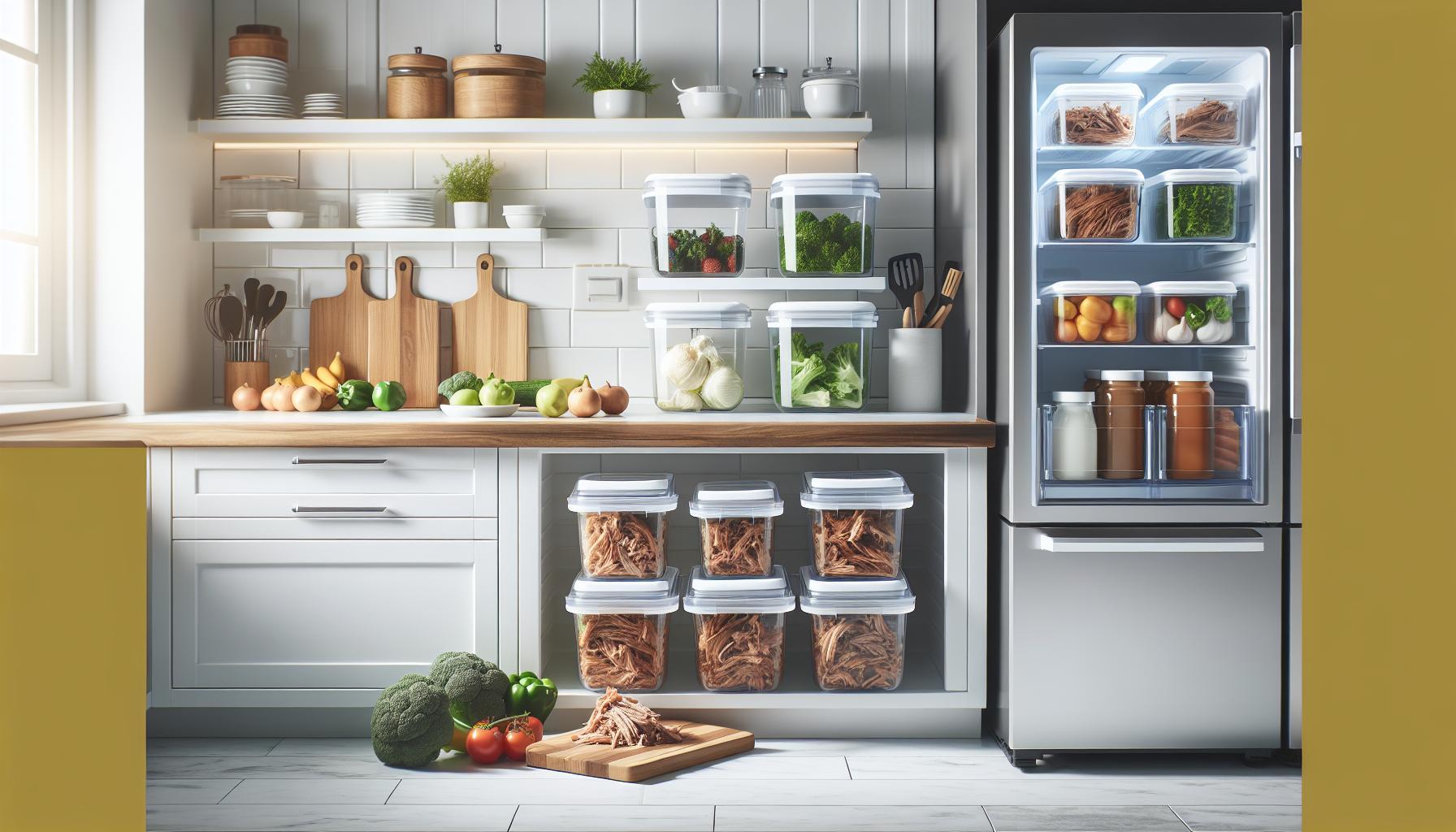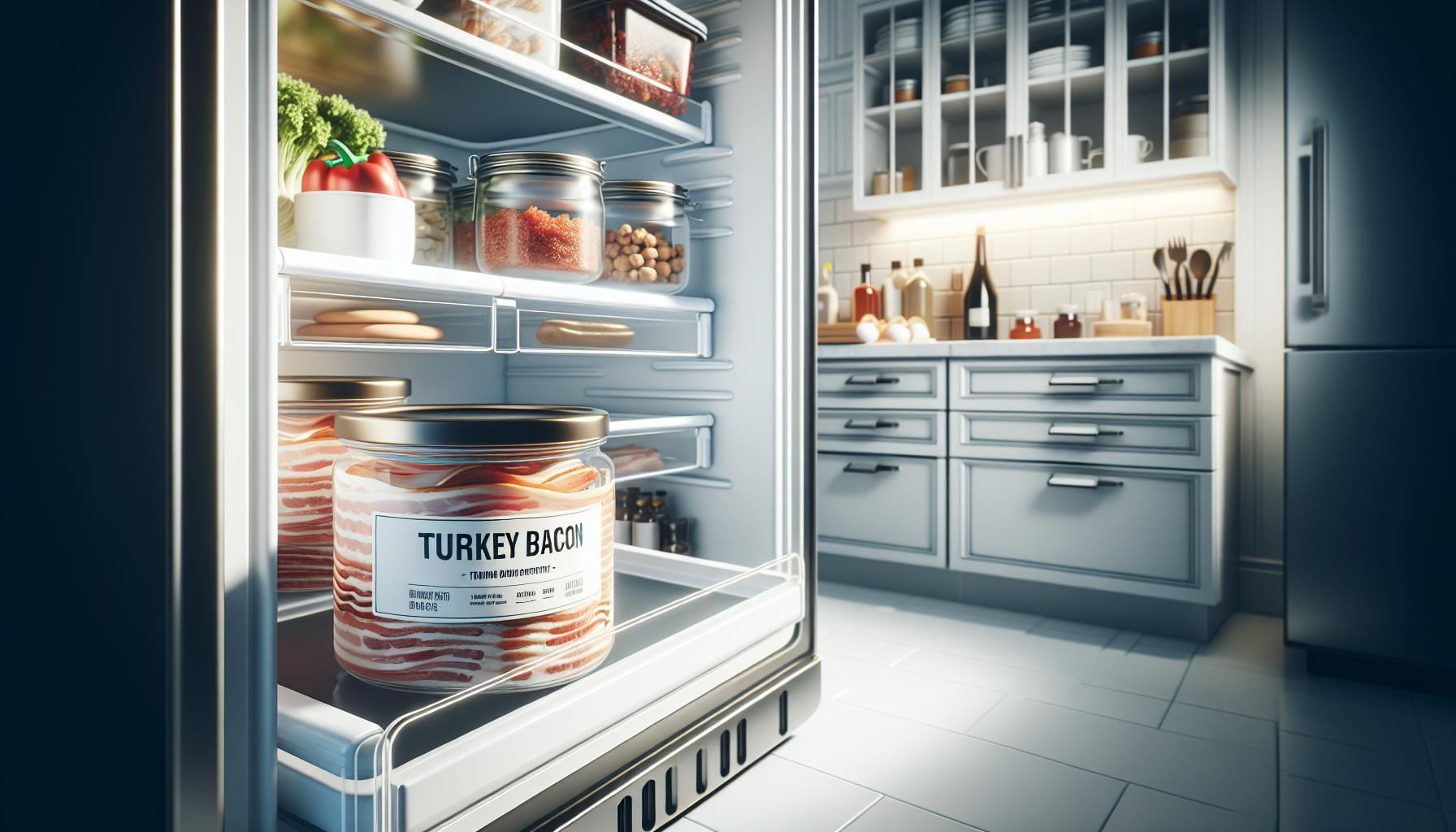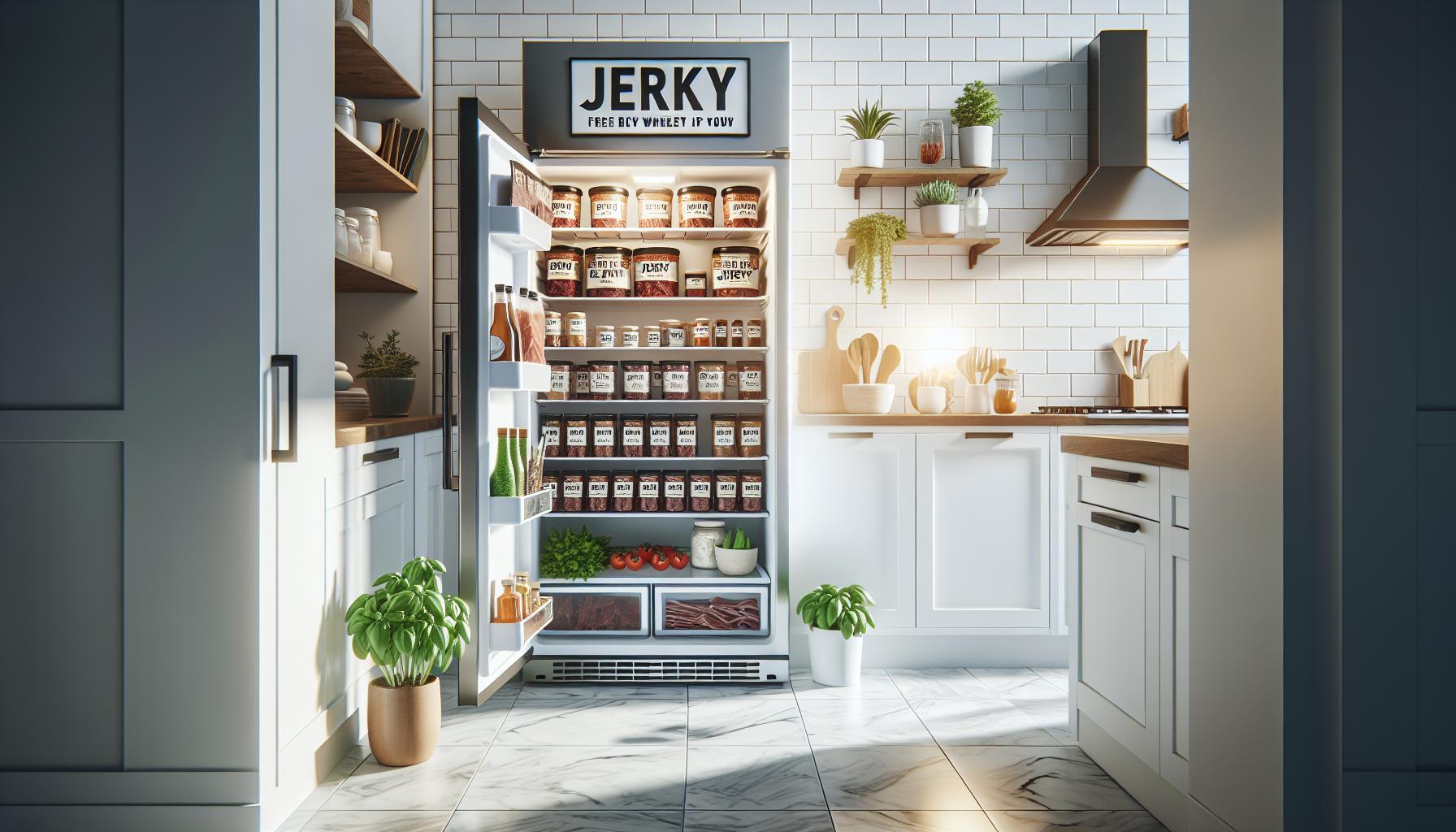Did you know that pepperoni is one of the most popular pizza toppings in America? This delicious cured sausage often finds its way into sandwiches and snacks, too. But once you’ve bought your pepperoni, whether for a party or your fridge, you might wonder: how long will it stay fresh?
Understanding the shelf life of pepperoni not only helps you enjoy it at its best but also ensures you manage food safety effectively. This guide will clarify how long pepperonis last in the fridge, providing you with practical storage tips and safety guidelines. Armed with this knowledge, you can confidently snack and cook, minimizing waste and maximizing flavor. Continue reading to discover how to make the most of your pepperoni so that every bite is as enjoyable as the last!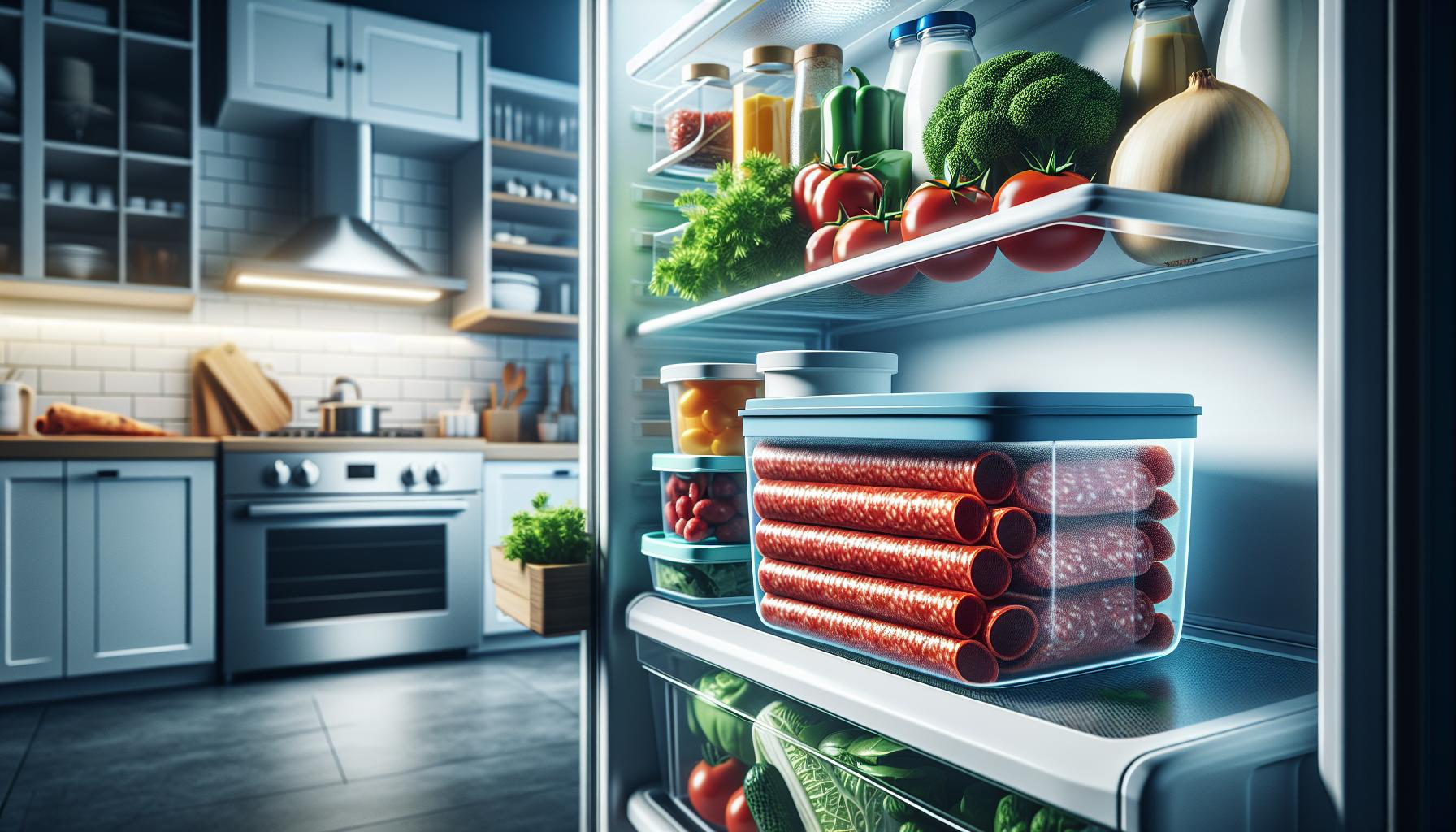
How Long Does Pepperoni Last in the Fridge?
Pepperoni is a beloved ingredient that enhances many meals, particularly pizzas and sandwiches. Understanding how long this popular cured meat can last in the fridge helps ensure food safety and flavor integrity. Typically, unopened pepperoni can last up to 6 weeks in the refrigerator. Once opened, you should aim to consume it within 3 weeks for the best quality. This timeline may vary based on factors like the specific product, packaging, and storage conditions.
When storing pepperoni, it’s important to keep it in an airtight container or resealable plastic bag to minimize exposure to air and moisture, which can accelerate spoilage. If pepperoni develops a slight discoloration or a change in texture, these can be indicators of diminished quality, although it may still be safe to eat if properly stored.
For those who want to extend its shelf life beyond the fridge, consider freezing pepperoni. When properly frozen, it can maintain its best quality for 1-2 months, but it remains safe indefinitely if kept at 0°F. Always make sure to use freezer-safe wrapping, as this further protects the meat from freezer burn, ensuring a delicious taste when you’re ready to use it again. Following these guidelines allows you to enjoy your favorite pepperoni dishes with confidence and ease.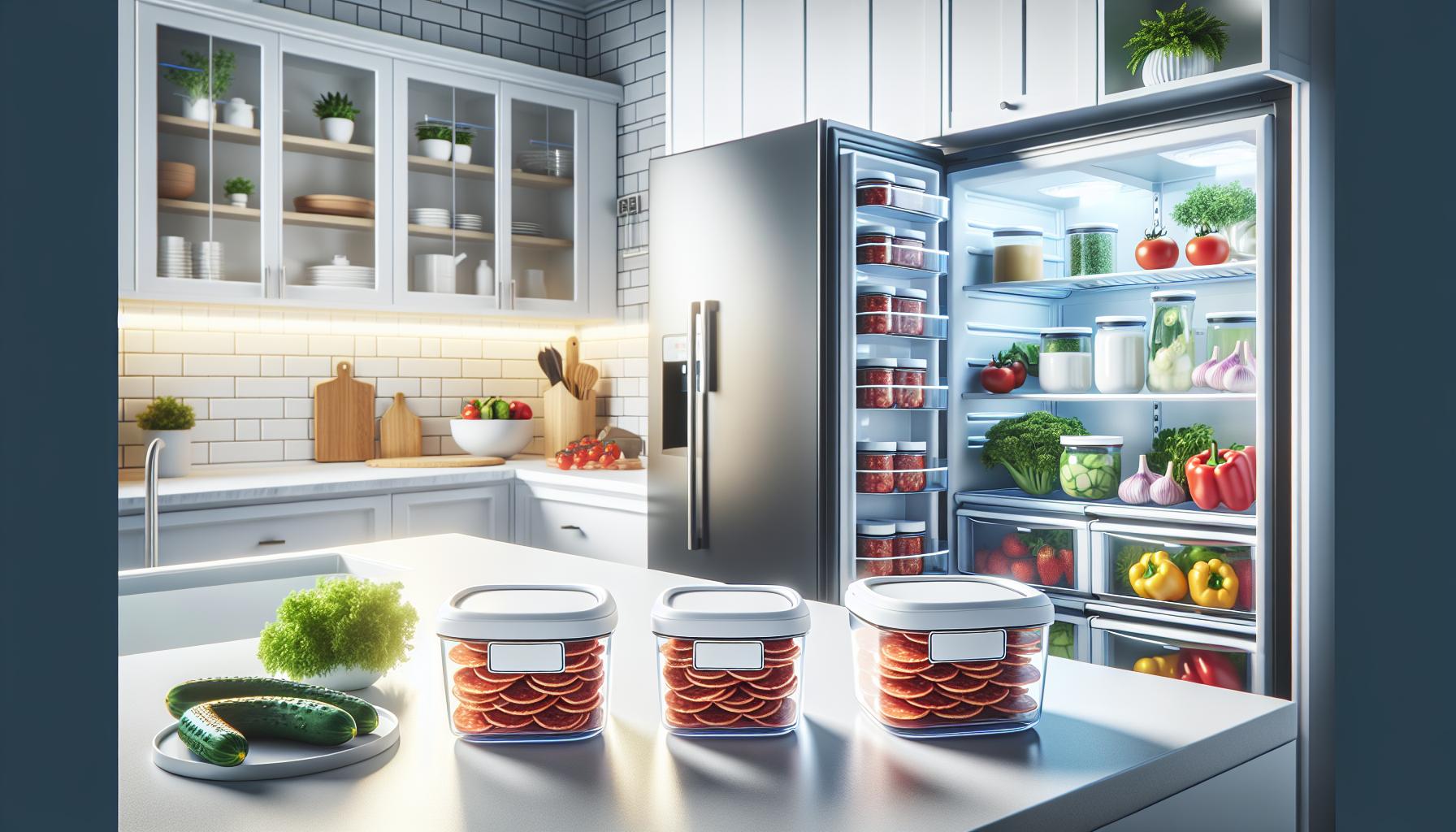
Understanding the Shelf Life of Pepperoni
Pepperoni, a favorite topping for pizzas and a staple in many kitchens, has a surprising shelf life that can help you enjoy it at its best for longer. Unopened packages of pepperoni can typically last up to 6 weeks in the refrigerator, while opened pepperoni should ideally be consumed within 3 weeks for optimal flavor and texture. is essential, not only to prevent waste but also to ensure food safety.
The shelf life can fluctuate based on various factors including the type of packaging and storage conditions. For instance, pepperoni stored in vacuum-sealed packaging tends to retain its freshness longer compared to those in less airtight conditions. It’s also helpful to check the “use by” or “sell by” dates on the packaging as a guideline. If the pepperoni appears to be nearing these dates, consuming it sooner rather than later may be wise to maintain the best taste and quality.
When assessing the shelf life and quality of pepperoni, paying attention to visual and sensory cues is crucial. Fresh pepperoni should maintain a bright red hue with a smooth texture. If you notice any signs of discoloration, such as dullness or greying, or if the pepperoni feels sticky or slimy, these are indicators it may be time to dispose of it. Additionally, an off-putting smell can be a clear sign that the product has gone bad. By adhering to proper storage practices and being mindful of these indicators, you can make the most out of your pepperoni, ensuring every bite remains delicious and safe to eat.
To extend its freshness beyond the fridge, proper freezing can be a game-changer. Frozen pepperoni can maintain its best quality for 1-2 months, and it remains safe indefinitely if kept at 0°F. Wrapping it securely in freezer-safe materials will protect it further from freezer burn and future spoilage, allowing you to always have this flavorful treat on hand for your culinary creations.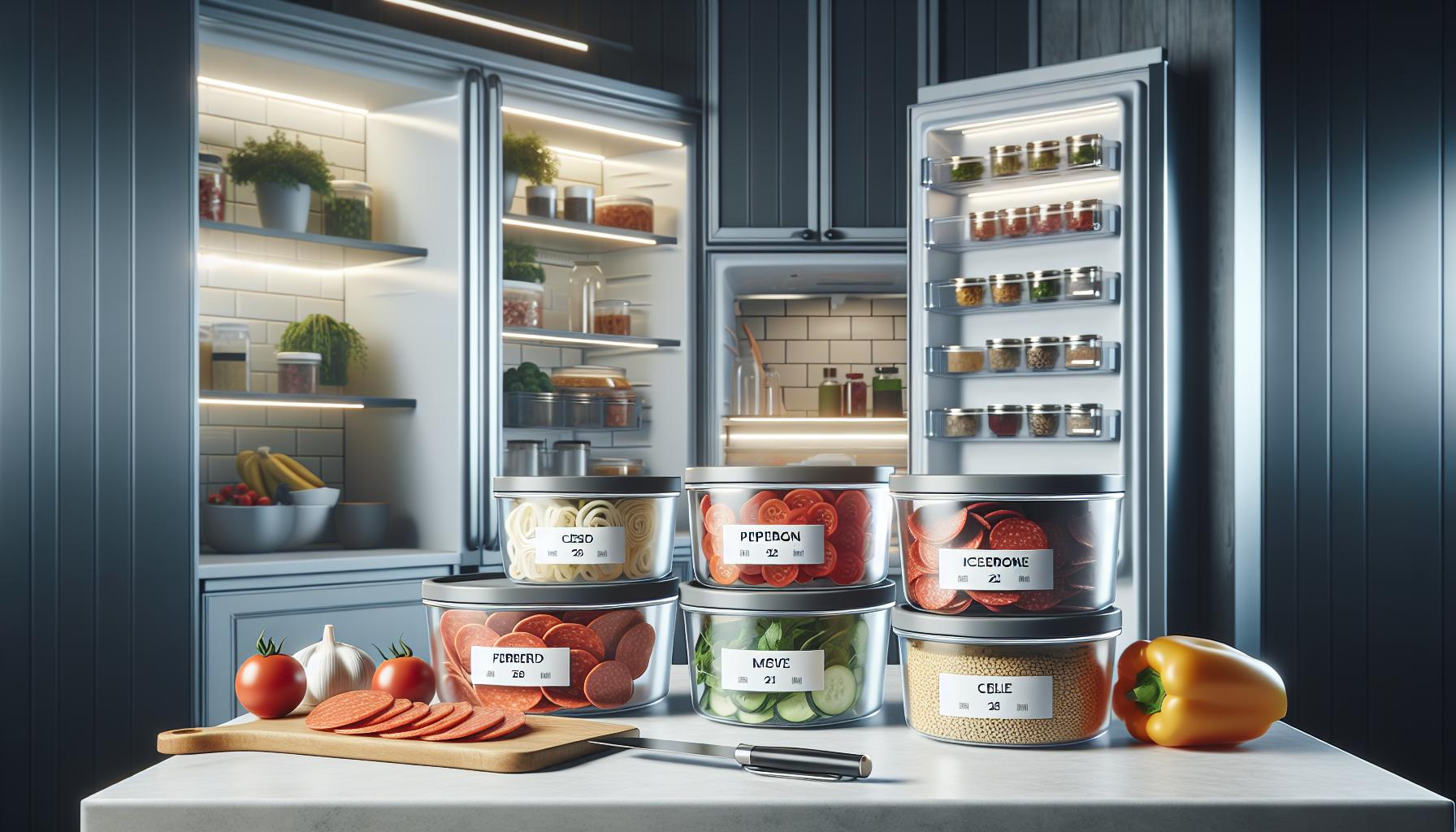
Signs Your Pepperoni Has Gone Bad
While pepperoni is a beloved ingredient in many kitchens, knowing how to recognize when it has gone bad is equally important to ensure food safety and maintain the quality of your dishes. Fresh pepperoni exhibits a bright red color and a smooth texture, but as time passes, several telltale signs may indicate that it’s no longer safe to eat.
- Color Change: Fresh pepperoni should have a vibrant red hue. If you notice a dull or greyish appearance, this is a strong indicator that the pepperoni is beginning to spoil.
- Texture: The texture of fresh pepperoni should be firm and slightly oily without feeling sticky or slimy. If the slices feel noticeably tacky or have an unpleasant slimy film, it’s best to discard them.
- Odor: A fresh pepperoni has a distinct, spicy aroma. However, if the smell is off-putting, sour, or rancid, this is a clear signal that the product has deteriorated and should not be consumed.
- Presence of Mold: Any visible mold on the pepperoni, particularly in unusual colors like green or fuzzy spots, is an unequivocal sign that the meat has gone bad and poses a health risk.
By staying vigilant about these indicators and regularly checking your pepperoni, you can avoid wasting food while ensuring your meals remain delicious and safe. Always remember the old adage, “When in doubt, throw it out,” and trust your senses to guide you in making safe food choices.
Best Practices for Storing Pepperoni
Properly storing pepperoni is essential not only for maintaining its flavor and quality but also for ensuring food safety. This beloved pizza topping can last longer when stored correctly, allowing you to enjoy its distinctive taste without worrying about spoilage. Here are some best practices to keep in mind when handling and storing pepperoni.
Start by sealing any opened packages tightly. If you’ve purchased sliced pepperoni, make sure to rewrap it tightly with plastic wrap or aluminum foil. For bulk pepperoni, consider placing smaller portions in airtight containers or resealable bags. This minimizes exposure to air, which can lead to oxidation and spoilage. Remember, when refrigerating, the ideal temperature is below 40°F (4°C). Keep your refrigerator organized so that pepperoni doesn’t sit too long on the shelves.
For longer-term storage, vacuum sealing is highly effective. This method removes air, drastically reducing the risk of spoilage while preserving flavor and texture. If you don’t have a vacuum sealer, you can use the submersion technique by placing a zip-top bag in water to push out excess air before sealing. Either way, vacuum-sealed pepperoni can last up to 6 months in the freezer. Be sure to label your packages with the date for easier tracking.
When using pepperoni directly from the fridge or freezer, avoid leaving it out at room temperature for extended periods-never more than two hours. This practice prevents the growth of harmful bacteria. After defrosting frozen pepperoni in the refrigerator, it’s best to consume it within a week for optimal freshness. By following these storage tips, you can ensure that your pepperoni remains delicious and safe for various culinary creations.
How to Extend the Freshness of Pepperoni
To keep pepperoni as fresh as possible, proper storage and handling techniques are crucial. This beloved cured sausage, made from a blend of pork and beef, can spoil quickly if not tended to correctly. Here are some effective methods to extend its shelf life and ensure you continue enjoying its robust flavor while minimizing waste.
Seal and Store Properly
After opening, it’s vital to limit pepperoni’s exposure to air. Tightly seal any opened packages using plastic wrap, aluminum foil, or airtight containers. For bulk pepperoni, consider dividing it into smaller portions that can be stored in resealable bags or containers. This approach not only reduces the risk of spoilage but also makes it easier to grab just the right amount when you’re ready to use it. Always store pepperoni in the refrigerator at a temperature below 40°F (4°C) to slow down the growth of bacteria.
Utilize Vacuum Sealing
For those looking to store pepperoni for an extended period, vacuum sealing is an excellent method. This technique removes air and creates an airtight seal, which drastically reduces spoilage while retaining flavor and texture. If you don’t have a vacuum sealer, a simple DIY alternative is the water displacement method: place your pepperoni in a zip-top bag and submerge it in water to push out excess air before sealing. Vacuum-sealed pepperoni can last up to six months in the freezer, so label your bags with dates for easy tracking.
Maintain Safe Temperatures
Always be mindful of how long pepperoni remains at room temperature. It should not be left out for more than two hours to prevent harmful bacterial growth. If you’ve thawed frozen pepperoni, consume it within one week for best quality.
Additionally, incorporating some creative usage strategies can help keep your pepperoni fresh. Consider incorporating it into your meals more frequently, like adding it to salads, pasta dishes, or homemade pizzas. Regularly including it in your meals will help prevent it from sitting too long and heading towards spoilage.
By following these simple yet effective practices, you can ensure that your pepperoni stays fresh longer, allowing for more delicious meals and snacks without the worry of food safety.
Safe Cooking Tips for Pepperoni Dishes
Cooking with pepperoni can elevate your dishes, but ensuring safety during preparation is crucial. When adding pepperoni to your meals, it’s important to handle it properly to avoid foodborne illnesses. Always start with fresh pepperoni, checking for expiration dates and proper storage signs. For the utmost safety, you should refrigerate opened pepperoni and consume it within three weeks. If you’re using pepperoni that has been frozen, make sure to thaw it in the refrigerator rather than at room temperature to prevent bacterial growth.
When incorporating pepperoni into dishes, consider cooking it briefly in a skillet or baking it with pizza. Heat is your ally; cooking pepperoni until it reaches an internal temperature of 160°F (71°C) ensures that any pathogens are killed. This practice brings out its bold flavor and crispy texture that many enjoy. Additionally, if you are using it in recipes like pasta or casseroles, layer it among other ingredients to help soak up flavors and distribute its spiciness evenly.
To further enhance flavor while maintaining safety, be mindful of cross-contamination. Use separate cutting boards and utensils for raw and cooked foods, and always wash your hands before and after handling raw pepperoni. If you are preparing a large batch of pepperoni dishes, ensure that leftovers are cooled and stored in airtight containers within two hours of cooking to minimize spoilage.
Incorporating pepperoni creatively can also prevent waste and keep meals interesting. Use leftover pepperoni slices in breakfast scrambles, on sandwiches, or in salads, allowing you to enjoy this flavorful sausage without risk of spoilage. By adhering to proper cooking safety and leveraging delicious usage ideas, you can confidently enjoy the robust taste of pepperoni in a variety of dishes.
Creative Ways to Use Leftover Pepperoni
There’s a world of culinary possibilities when it comes to using up leftover pepperoni, that deliciously spicy, cured sausage that has likely become a staple in your kitchen. Instead of simply tossing those extra slices when they start to linger in the fridge, consider these creative and delectable ideas to make the most out of this flavorful ingredient while also minimizing waste.
One easy and delightful way to use leftover pepperoni is by incorporating it into breakfast dishes. For instance, sprinkle chopped pieces into scrambled eggs or omelets for a quick meal that brings a zesty kick to your morning routine. Alternatively, you can layer them on a breakfast burrito or quesadilla alongside eggs, cheese, and veggies for a hearty start to your day.
Pizza-inspired snacks are another fantastic option. Use the pepperoni slices in homemade pizzas or pizzas on pita bread for a quick lunch or dinner. For bite-sized treats, try making pepperoni chips by baking thin slices until they crisp up-perfect as a topping for salads or as a plain snack. Pair these with dips like marinara or ranch for an added flavor punch.
Incorporating pepperoni into pasta dishes can also elevate your weekly meals. Toss slices into spaghetti, casseroles, or baked ziti just before serving. The pepperoni will add a savory flavor and a pleasant texture contrast, making family favorites even more satisfying. Alternatively, you could also blend it into a creamy pepperoni Alfredo sauce for a luxurious, comforting dish.
Lastly, consider adding pepperoni to your snack platter. It pairs exceptionally well with cheeses, olives, and crackers, creating a gourmet charcuterie experience at home. This not only enhances the flavor of the platter but also makes use of leftovers in an elegant and appealing way.
No matter how you choose to repurpose your leftover pepperoni, these ideas ensure you enjoy its robust flavor while adhering to safe storage practices. Ensure any remaining slices are stored in airtight containers, and remember to consume them within three weeks to enjoy both safety and deliciousness in your dishes.
Pepperoni Storage: Vacuum Sealing vs. Freezing
The choice between vacuum sealing and freezing pepperoni can significantly impact its longevity and quality. Vacuum sealing removes air from the packaging, reducing spoilage and maintaining the pepperoni’s flavor and texture. This method is particularly effective for short-term storage. When vacuum-sealed, opened packages of pepperoni can last for up to two to three weeks in the refrigerator and even longer in the freezer-up to six months, ensuring the spicy flavor remains intact.
On the other hand, freezing vacuum-sealed pepperoni provides an excellent solution for those who want to keep it for an extended period. When stored properly in a freezer-safe bag or container, pepperoni can maintain its best quality for about 6 to 12 months. Implementing these storage methods not only prevents freezer burn but also preserves the overall taste. If you don’t have a vacuum sealer, tightly wrapping the pepperoni in plastic wrap or aluminum foil before placing it in a more substantial freezer bag can also be effective.
Here’s a quick comparison:
| Storage Method | Refrigerator Duration | Freezer Duration |
|---|---|---|
| Vacuum Sealing | 2-3 weeks | 6 months |
| Freezing (without vacuum sealing) | 1-2 weeks | 6-12 months |
To ensure the best outcome, always label packages with the date of storage. When you’re ready to use frozen pepperoni, defrost it in the refrigerator overnight to maintain quality and safety. These practices empower you to snack and cook with confidence, knowing that your pepperoni will be ready and fresh whenever you need it.
How to Tell If Your Pepperoni is Safe to Eat
Determining the safety of your pepperoni is essential to enjoying it without worry. The first step is to check the expiration date printed on the package, but that alone isn’t enough. Visual inspection is crucial; fresh pepperoni should have a vibrant red color. If you notice any unusual gray or green spots, it could be a sign of spoilage. Additionally, inspect the packaging for any swelling; this can indicate bacterial growth and potential spoilage.
Another key indicator of freshness is smell. Fresh pepperoni has a mildly spicy, savory aroma. If your pepperoni has developed a sour or off-putting smell, it’s best to err on the side of caution and discard it. Texture also plays a role; fresh pepperoni will feel slightly oily but not slimy. If you notice a slimy surface, it is a red flag that the product may have turned.
For those who have stored pepperoni in the refrigerator, it’s advisable to consume it within the advised timeframe to maintain safety and quality. Always label your packages with packing or opening dates to track freshness effectively. When in doubt, it’s safer to throw it out, as consuming spoiled meat can lead to foodborne illnesses. Following these practical steps will help ensure that your pepperoni is safe and enjoyable to eat, allowing you to make the most of this beloved topping in your culinary endeavors.
Nutritional Value of Pepperoni: What to Know
Pepperoni is not just a popular pizza topping; it’s also packed with flavors and nutrients that can be part of a balanced diet when consumed in moderation. Known for its rich, savory taste, pepperoni predominantly consists of pork and beef, making it a significant source of protein. A typical serving (about 1 ounce) of pepperoni can provide approximately 9 grams of protein, which is essential for muscle repair and growth.
However, it’s important to note that pepperoni is also relatively high in fat and sodium. A single serving can contain around 11 grams of fat, of which about 4 grams may be saturated fat. The sodium content can be considerable, often exceeding 400 milligrams per serving. This is crucial information for those who need to manage their sodium intake for health reasons, such as hypertension.
Health Considerations
While pepperoni can be enjoyed as part of various dishes, its nutritional profile suggests that moderation is key. Consuming it too often may lead to excessive intake of saturated fats and sodium, which can increase the risk of heart disease and other health issues.
To enjoy pepperoni healthily, consider these tips:
- Opt for turkey or plant-based pepperoni variants, which tend to have lower fat content.
- Incorporate pepperoni into dishes rich in vegetables and whole grains to balance its high-fat content.
- Limit portion sizes to control calorie and sodium intake.
Moreover, when considering how long pepperoni lasts in the fridge, it’s advisable to consume opened packages within 3 to 4 weeks to ensure freshness and reduce the risk of spoilage. Always prioritize safety by checking for any signs of spoilage before use, such as discoloration or an off smell. Understanding the nutritional value allows for smarter choices that satisfy both taste and health requirements.
Comparing Fresh, Dried, and Cured Pepperoni
When it comes to pepperoni, understanding its various forms-fresh, dried, and cured-can significantly impact its shelf life, taste, and versatility in recipes. Fresh pepperoni, typically found in the deli section, must be consumed relatively quickly, generally within 1 week if stored properly in the fridge. Its high moisture content can lead to spoilage more swiftly than its counterparts, making immediate use essential for optimal flavor and safety.
On the other hand, dried pepperoni, which undergoes a drying process that reduces moisture, has a longer shelf life. This form can last several weeks when sealed and stored in a cool, dry place or up to 6 weeks in the refrigerator. Dried pepperoni retains its robust flavor while becoming an ideal snack or ingredient in various dishes, from salads to charcuterie boards.
Cured pepperoni is the most common type, typically made from a combination of pork and beef, seasoned, and then cured with salt and spices. It can remain safe to consume for several months when stored unopened in a cool, dry place. Once opened, it’s advisable to consume cured pepperoni within 3 to 4 weeks when kept in the refrigerator. The curing process not only helps preserve the pepperoni but also enhances its distinct smoky and spicy flavors, making it a staple in pizzas and sandwiches.
To ensure the best quality regardless of the type, always check packaging labels for specific storage instructions, and remember that the method of storage-whether vacuum-sealed, wrapped tightly, or kept in an airtight container-can greatly affect freshness and longevity. Understanding these differences will help you enjoy your pepperoni in its best form, reducing waste and enhancing your culinary creations.
Q&A
Q: How can I tell if my pepperoni is still good to eat?
A: To determine if pepperoni is still good, check for any discoloration, off smells, or a slimy texture. If it appears dry or has changed color significantly, it’s best to discard it. For more details, see the section on signs your pepperoni has gone bad.
Q: What is the best way to store unopened pepperoni?
A: Unopened pepperoni should be stored in a cool, dry place. Once opened, wrap it tightly in plastic wrap or aluminum foil and place it in the fridge. Proper storage can extend its freshness significantly, as detailed in our best practices for storing pepperoni section.
Q: Can you freeze pepperoni to extend its shelf life?
A: Yes, freezing pepperoni can effectively extend its shelf life. Ensure it’s wrapped tightly to prevent freezer burn. For specific steps on freezing and thawing pepperoni safely, refer to our section on pepperoni storage: vacuum sealing vs. freezing.
Q: How long does pepperoni last past its expiration date?
A: Pepperoni can last a few weeks past its expiration date if stored properly in the fridge, although quality may decline. Always inspect for signs of spoilage before consumption. For more information, consider reading about understanding the shelf life of pepperoni.
Q: Can leftover pepperoni be used in other dishes?
A: Yes, leftover pepperoni can be creatively used in various dishes such as pizzas, omelets, or salads. Check our section on creative ways to use leftover pepperoni for more ideas and inspiration.
Q: How should I defrost frozen pepperoni safely?
A: The safest way to defrost frozen pepperoni is to transfer it to the refrigerator for several hours or overnight. This prevents bacterial growth. For more defrosting tips, see our safe cooking tips for pepperoni dishes section.
Q: Is it safe to eat pepperoni if it’s been left out overnight?
A: No, it is not safe to eat pepperoni that has been left out at room temperature for more than two hours. Always refrigerate pepperoni promptly to prevent foodborne illness. More on this can be found in our section on how to tell if your pepperoni is safe to eat.
Q: Do different types of pepperoni have different shelf lives?
A: Yes, fresh pepperoni typically has a shorter shelf life compared to dried or cured varieties. Cured pepperoni can last longer due to preservation techniques. Check the comparing fresh, dried, and cured pepperoni section for more detailed information.
Wrapping Up
Now that you know how long pepperonis last in the fridge, you can confidently add them to your meals without worry. Remember, storing them properly can maximize freshness and flavor, helping you enjoy tasty snacks and dishes for longer. If you’re looking for more storage tips or recipes, check out our guides on the best ways to store deli meats and delicious pizza toppings to elevate your cooking game.
Don’t forget to subscribe to our newsletter for more expert advice on food safety and meal preparation, ensuring you always make informed decisions in the kitchen. Got questions or a favorite pepperoni recipe? Share your thoughts in the comments below! Stay confident and snack wisely, and explore our site for more helpful resources that keep your culinary adventures exciting.


